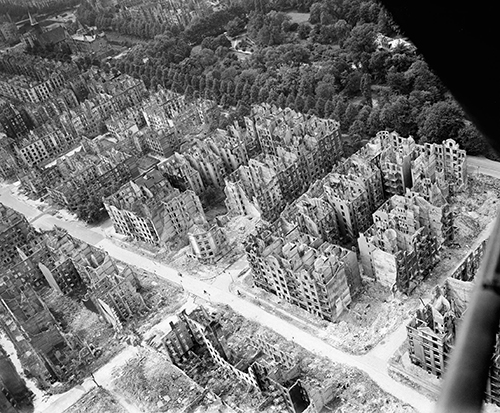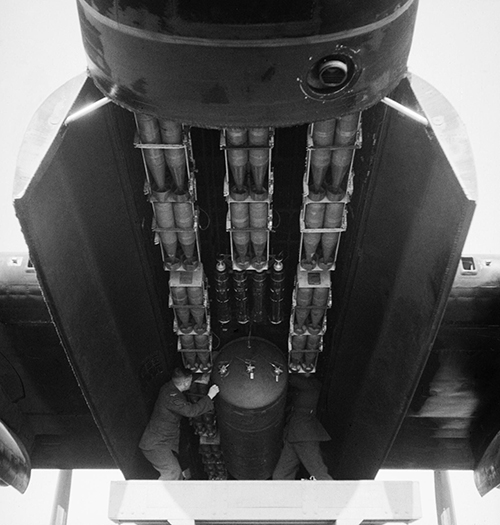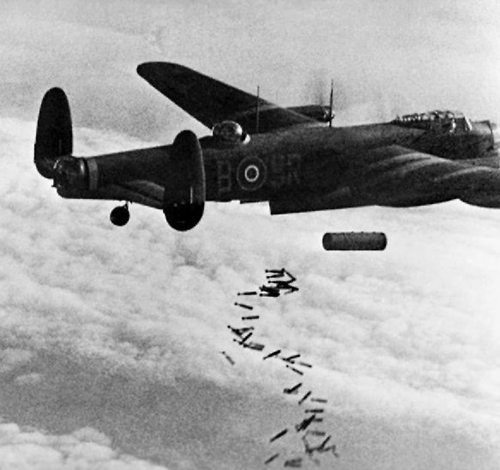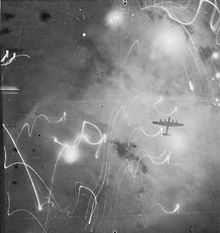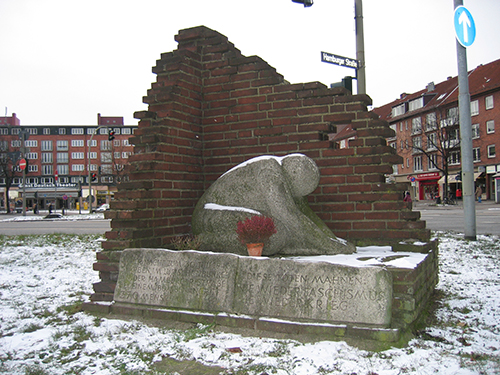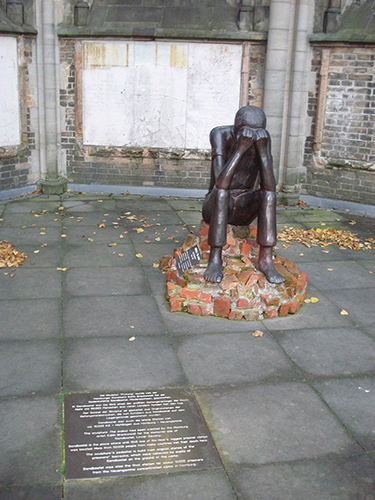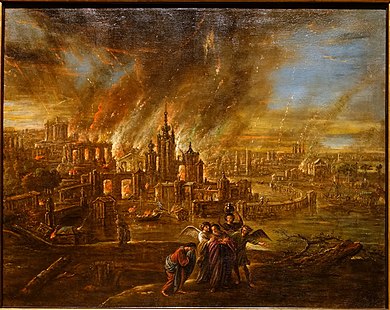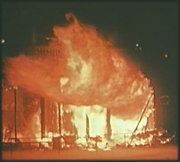“Then the LORD rained upon Sodom and upon Gomorrah brimstone and fire from the LORD out of heaven… And he looked toward Sodom and Gomorrah, and toward all the land of the plain, and beheld, and, lo, the smoke of the country went up as the smoke of a furnace.”
King James Bible Genesis 19: 24 et seq
Operation Gomorrah was the code name for a week-long bombing campaign against the German port of Hamburg commencing July 23rd, 1943, three months after Operation Chastise.
Hamburg qualified as a legitimate military target as it had Germany’s largest docks and numerous factories producing armaments and war materiel. However, target selection by the RAF was conducted using the ‘dehousing’ policy advocated by Churchill’s scientific advisor Lord Cherwell, who argued that bombing workers’ homes and neighborhoods had a more long-lasting effect on Germany’s economy than simply just bombing the factories: bombed-out workers would be traumatized, hungry, sick, and unable to find adequate shelter for months.
Having suffered under the ‘blitz,’ the German bombing of British cities from 1940 to 1942, RAF analysts concluded that fires were more destructive of cities than high explosive. Therefore, Gomorrah was specifically designed to start fires.
The Allies used specially designed bomb loads to maximize the incendiary effects of bombing including techniques to hamper firefighters.
A Lancaster being bombed-up with a USUAL bomb load (the bomb bay is 33 feet long).
A ‘cookie’ and incendiary clusters on their way toward the target.

The bomb loads used by the RAF on the Gomorrah missions were codenamed USUAL. They consisted of one 4,000 lb. High-Capacity bomb filled with Amatol explosive, and twelve Small Bomb Containers. Each SBC contained 236 incendiary bomblets weighing 4 lbs. each; thus, a Lancaster bomber typically carried more than 3,000 individual incendiary devices. Incendiaries were usually based on magnesium as the combustible material; magnesium burns at approximately 4000ºF.
The 4,000 lb. bombs, known as ‘cookies,’ were fused to explode after impact. The plan was to let the massive two-ton cylinder crash through a building’s roof and smash through the floors below before exploding deep in the building and blowing out the windows to maximize air drafts. The incendiaries would fall through the holes and scatter through the building before igniting. The resulting fire would be fed by air rushing in through the lower windows while the upper structural damage became a chimney. Some incendiaries had belayed-action fuses designed to rekindle fires as firefighters attempted to put them out.
Some Lancasters carried conventional High Explosive bomb loads, typically the code-named ABNORMAL load of 14 x 1,000 lb. HE bombs (approximately 7 tons) with long-delay fuses, from an hour up to 6 days, to discourage firefighters attempting to control the blaze.
In another planned strategy against firefighters, it was assumed that firefighters from near-by cities would rush to assist in Hamburg. Therefore the 8th Air Force firebombed Hannover on July 26th knowing all its firefighters had gone to help Hamburg and Hannover’s fires burned unchecked.
The RAF used Lancaster bombers with a smaller number of Halifaxes and, on one raid, obsolescent Stirlings. The RAF also conducted nuisance raids by fast Mosquitos to keep German defenses on high alert and to prevent them from sleeping, and to unnerve firefighters.
Gomorrah also showcased the first full use of three important techniques in one operation: the use of Pathfinders (35 Squadron) to lay down markers (Target Indicators), so that the best pilots went first to find the target and dropped bright TI flares while the rest just aimed at the flares; the dropping of large amounts of aluminum foil strips (known as WINDOW) to blind German radar; and the use of the new H2S radar that could map the ground.
The USAAF Eighth Air Force, flying by day, used B 17 Flying Fortresses.
The operation started on the night of July 24/25th and ended on August 2/3rd , and included two raids by B 17s, three raids by Bomber Command involving over 700 aircraft each, two nuisance raids by Mosquitos and no less than four additional mass raids cancelled because of adverse weather. The chart below summarized these events.
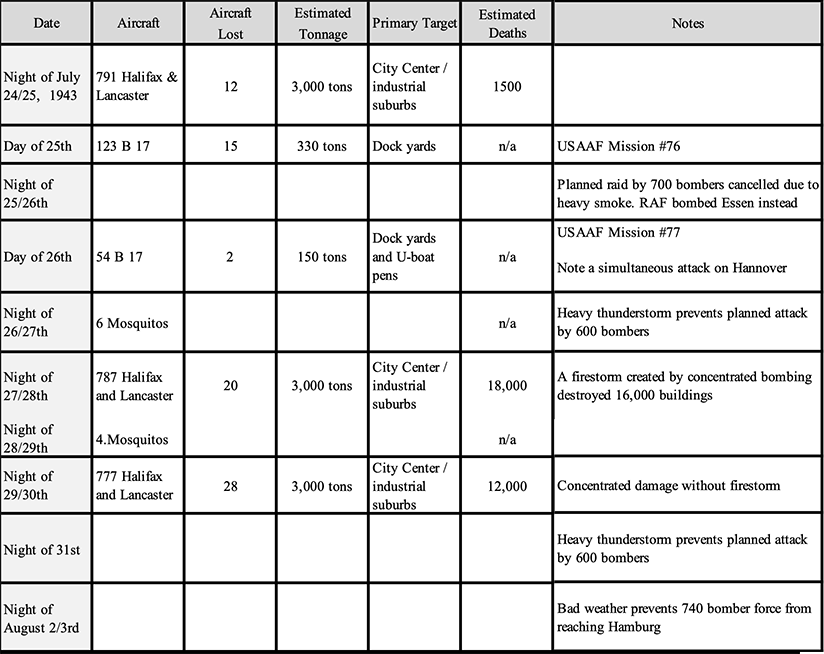
The most historically significant of these raids occurred on the night of July 27th/28th, when almost 800 bombers dropped approximately 3,000 tons of bombs into a densely populated area one mile by two, all in less than an hour.
The bombing of Dresden in 1945 is often cited as the most violent of all raids in the European theater in World War II, but Hamburg was more damaging. The RAF’s incendiary strategy was highly successful. Hundreds of significant fires were started, overwhelming the firefighters. As the fires built they created a firestorm of winds up to 150 mph. rushing in at ground level and rising like a tornado to almost 1,000 feet. Surface temperatures reached 800ºC. Many civilians were literally swept off their feet into the firestorm. Approximately 18,000 died on that one night, many from asphyxiation in bomb shelters from which all the air had been sucked. In some cases, the victims were reduced to ashes and their numbers could only be estimated.
A Lancaster above the fires. The white lines are flak.
Including all the raids an estimated 34,000 to 40,000 died, although numerous credible sources put the number much higher, such as the postwar US Strategic Bombing Survey which put the number at 60,000 to 100,000. 250,000 homes and houses were destroyed and several thousand factories and businesses. Hamburg never recovered its economy in the remaining two years of the war. Some observers believed Hamburg was more severely damaged than Nagasaki.
It is important to note that Hamburg suffered three heavy raids in a week but four more were cancelled due to adverse weather: one can but speculate as to what might have happened if those raids had also been completed.
Of course, Hamburg has long since been rebuilt and is a thriving major European city. But among the modern splendors there are reminders—for those who choose to seek them out—of that fatal week in July.
Ohisdorf memorial for those in mass graves.
The dead are transported across the Styx.
The Hamburgerstrasse memorial
In St Nicholas church
The Hamburgerstrasse memorial to people who died in an air raid shelter reads, in part: “Remember these dead. Never again fascism. Never again war.”
‘Sodom and Gomorrah afire’ by Jacob de Wet II, 1680
Hamburg, 1943, Source: www.bombenkrieg.net
“…and, lo, the smoke of the country went up as the smoke of a furnace.”
Alas the furies of 1943 were far from over. In fact, Operation Tidal Wave had already taken place even before Operation Gomorrah was over, as I shall describe in my next blog.



